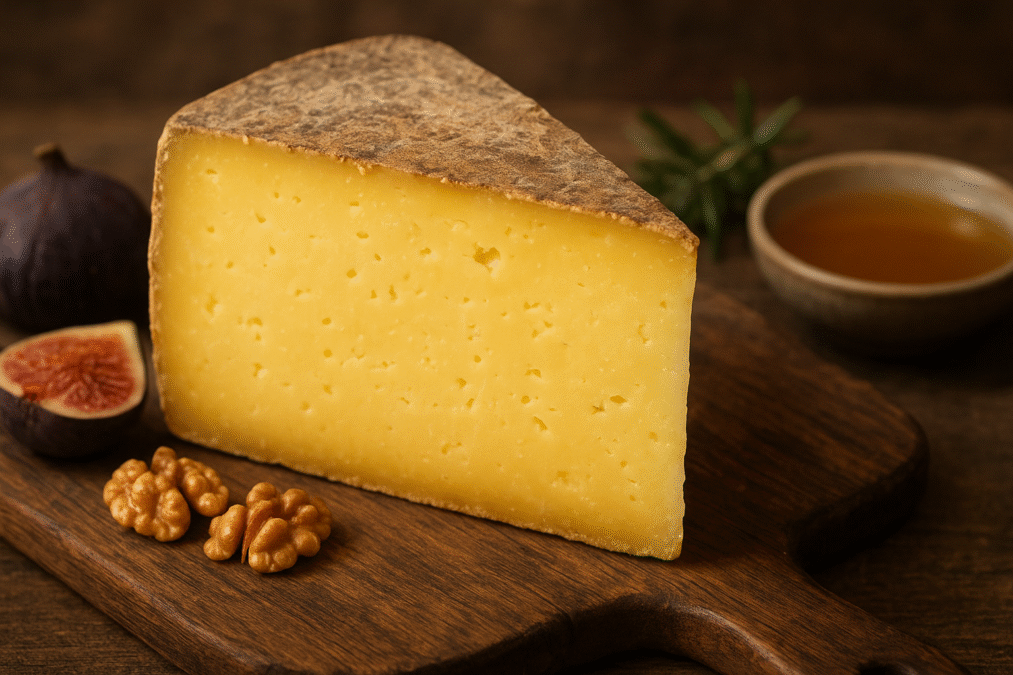Gruyère cheese, often hailed as one of Switzerland’s most iconic exports, is a versatile and flavorful hard cheese that has captured the hearts of food enthusiasts worldwide. Known for its nutty, slightly sweet taste and smooth texture, Gruyère is a staple in fondue, gourmet sandwiches, and fine dining. If you’re searching for information on Gruyère cheese—its history, production process, culinary uses, and more—this comprehensive guide will cover everything you need to know. Whether you’re a cheese connoisseur or a curious beginner, dive into the world of Gruyère cheese and discover why it’s a must-have in your kitchen.
In this SEO-optimized article, we’ll explore the origins of Gruyère cheese, how it’s made, its nutritional profile, popular recipes, and tips for buying and storing it. By the end, you’ll be equipped with expert knowledge to appreciate and incorporate this Swiss gem into your meals. Let’s get started!
The Rich History of Gruyère Cheese
Gruyère cheese traces its roots back to the medieval era in the Gruyère region of Switzerland, specifically in the canton of Fribourg. The name “Gruyère” is derived from the town of Gruyères, a picturesque village nestled in the Swiss Alps. Historical records suggest that cheese production in this area began as early as the 12th century, with monks and local farmers perfecting the craft over generations.
The cheese gained international recognition in the 17th century when Swiss merchants exported it across Europe. By the 19th century, Gruyère had become a symbol of Swiss culinary excellence. In 2001, it earned Protected Designation of Origin (PDO) status from the European Union, ensuring that only cheese produced in specific Swiss regions using traditional methods can bear the name “Gruyère.” This protection preserves the authenticity and quality that make Gruyère stand out.
Interestingly, there’s often confusion with similar cheeses like Emmental (famous for its holes), but Gruyère is distinct with its denser texture and lack of large eyes. Today, Gruyère cheese production is a blend of tradition and modern efficiency, with annual output exceeding 30,000 tons in Switzerland alone. Its global popularity has led to imitations, but true Gruyère remains a testament to Swiss heritage.
How Gruyère Cheese Is Made: A Step-by-Step Process

Understanding the production of Gruyère cheese reveals why it’s so special. This cheese is crafted from raw cow’s milk sourced from cows grazing on alpine pastures, which imparts a unique flavor influenced by the region’s flora.
Step 1: Milk Collection and Preparation
Fresh milk is collected twice daily from local farms and delivered to the cheese dairy. It’s heated to around 31°C (88°F) in large copper vats, preserving the natural enzymes and bacteria that contribute to the cheese’s taste.
Step 2: Adding Cultures and Rennet
Starter cultures (lactic acid bacteria) are added to acidify the milk, followed by rennet, a natural enzyme that coagulates the milk into curds. This process takes about 30-40 minutes, forming a gel-like substance.
Step 3: Cutting and Heating the Curds
The curd is cut into small grains using a tool called a “cheese harp.” It’s then gently heated to 55°C (131°F) while stirring, which expels whey and firms up the curds. This step is crucial for Gruyère’s signature texture—firm yet creamy.
Step 4: Pressing and Molding
The curds are transferred to large round molds lined with cheesecloth. They’re pressed under heavy weights for up to 20 hours to remove excess whey and shape the wheels, which typically weigh 25-40 kg (55-88 lbs).
Step 5: Brining and Aging
After pressing, the wheels are soaked in a brine solution for 24 hours to develop the rind and enhance flavor. Then, they’re aged in temperature-controlled cellars for a minimum of 5 months. Gruyère can be aged longer—up to 12 months or more—for varieties like “Réserve” or “Vieux,” which offer deeper, more complex notes.
The entire process adheres to strict PDO guidelines, ensuring no additives or pasteurization, which keeps the cheese raw and full of probiotics. This meticulous craftsmanship results in Gruyère’s nutty, earthy flavor with hints of fruit and caramel as it matures.
Types and Varieties of Gruyère Cheese
Gruyère cheese comes in several varieties based on aging time, each offering a unique taste profile:
- Classic Gruyère (5-6 months): Mild and creamy, perfect for melting in dishes like fondue or gratins.
- Réserve Gruyère (8-10 months): Nutttier with a firmer texture, ideal for cheese boards.
- Vieux or Old Gruyère (12+ months): Intense and crystalline, with a sharp, savory bite—great for grating over pasta.
- Alpage Gruyère: Made from summer milk of high-altitude cows, this seasonal variety has a more floral, herbaceous flavor.
In the U.S., you might encounter “American Gruyère,” but it’s not authentic PDO. For the real deal, look for the Swiss AOC label.
Nutritional Benefits of Gruyère Cheese
Gruyère cheese isn’t just delicious—it’s nutritious too. A 1-ounce (28g) serving provides:
- Calories: About 110
- Protein: 8g (high-quality, complete protein for muscle repair)
- Fat: 9g (mostly saturated, but includes beneficial CLA for heart health)
- Calcium: 280mg (28% DV, supporting bone health)
- Vitamin A: 8% DV (for vision and immune function)
- Other Nutrients: Vitamin B12, phosphorus, and zinc
As a raw milk cheese, Gruyère retains live probiotics that aid gut health. It’s naturally low in lactose, making it suitable for those with mild lactose intolerance. However, moderation is key due to its calorie density. Studies from the Journal of Dairy Science highlight how aged cheeses like Gruyère can contribute to a balanced diet, potentially reducing inflammation and supporting weight management when consumed mindfully.
Culinary Uses: How to Enjoy Gruyère Cheese
Gruyère’s excellent melting properties make it a kitchen superstar. Here are some popular ways to use it:
In Fondue
The classic Swiss fondue recipe calls for Gruyère melted with white wine, garlic, and kirsch. Dip bread, vegetables, or apples for a cozy meal.
In Sandwiches and Paninis
Layer Gruyère with ham on rye bread for a Croque Monsieur, or add it to a gourmet grilled cheese with caramelized onions.
In Soups and Gratins
Grate Gruyère over French onion soup or mix it into potato gratin (like au gratin potatoes) for a creamy, bubbly topping.
On Cheese Boards
Pair aged Gruyère with fruits like pears, nuts, honey, and crisp white wines like Chardonnay.
Innovative Recipes
Try Gruyère in quiches, mac and cheese, or even stuffed into burgers for a gourmet twist.
Easy Gruyère Cheese Recipes to Try at Home
Recipe 1: Classic Swiss Fondue (Serves 4)
- Ingredients: 1 lb Gruyère cheese (grated), 1 cup dry white wine, 1 tbsp cornstarch, 1 garlic clove, 1 tsp lemon juice, pinch of nutmeg.
- Instructions: Rub garlic inside a fondue pot. Mix cheese with cornstarch. Heat wine, add cheese gradually while stirring until melted. Add lemon and nutmeg. Serve with bread cubes.
- Prep Time: 15 minutes. This recipe highlights Gruyère’s meltability and pairs perfectly with a chilled Sauvignon Blanc.
Recipe 2: Gruyère and Mushroom Quiche
- Ingredients: 1 pie crust, 1 cup grated Gruyère, 8 oz mushrooms (sautéed), 4 eggs, 1 cup cream, salt, pepper.
- Instructions: Preheat oven to 375°F. Layer mushrooms and cheese in crust. Whisk eggs and cream, pour over. Bake 35-40 minutes until set.
- Why It Works: Gruyère adds a nutty depth that complements the earthy mushrooms.
These recipes are simple yet showcase Gruyère’s versatility, making it ideal for both everyday meals and special occasions.
Buying and Storing Gruyère Cheese: Tips for Freshness
When shopping for Gruyère cheese, opt for specialty cheese shops or online retailers like Murray’s Cheese or igourmet. Look for the AOP/PDO seal to ensure authenticity. Prices range from $15-25 per pound, depending on age.
Store Gruyère in the fridge, wrapped in wax paper or cheese paper to allow breathing—avoid plastic wrap to prevent moisture buildup. It lasts 4-6 weeks refrigerated or can be frozen for up to 3 months (though texture may change slightly).
If you notice mold on the rind, it’s often harmless; simply cut it away. For the best flavor, let it come to room temperature before serving.
Gruyère Cheese in Popular Culture and Pairings
Gruyère has appeared in films like Ratatouille and is a favorite among celebrity chefs like Julia Child. Pair it with beers like pale ales or wines such as Pinot Noir for optimal enjoyment. In Switzerland, it’s central to festivals like the Gruyère Cheese Festival, celebrating its cultural significance.
Potential Drawbacks and Alternatives
While delicious, Gruyère is high in sodium (about 200mg per ounce), so those on low-sodium diets should consume it sparingly. Alternatives include Comté (French) or Appenzeller (Swiss) for similar flavors.
FAQs About Gruyère Cheese
Is Gruyère cheese the same as Swiss cheese?
No, “Swiss cheese” often refers to Emmental. Gruyère is denser and hole-free.
Can Gruyère be eaten raw?
Yes, it’s excellent raw on platters or in salads.
Is Gruyère gluten-free?
Yes, as it’s made solely from milk, cultures, and rennet.
How do you pronounce Gruyère?
It’s “gree-AIR” or “groo-YAIR.”
Where can I buy authentic Gruyère cheese?
Look for Swiss imports at Whole Foods, specialty stores, or online.
Conclusion: Why Gruyère Cheese Deserves a Spot in Your Pantry
Gruyère cheese embodies the essence of Swiss tradition with its rich history, meticulous production, and endless culinary possibilities. From fondue parties to elegant cheese boards, this versatile cheese elevates any dish. With its nutritional benefits and global appeal, it’s no wonder Gruyère remains a favorite among food lovers.
If you’re inspired to try Gruyère cheese, start with a classic fondue recipe or visit a local fromagerie. For more cheese guides and recipes, bookmark this page and explore related topics like Swiss fondue variations or cheese pairing ideas. Share your Gruyère experiences in the comments—happy cheesing!



